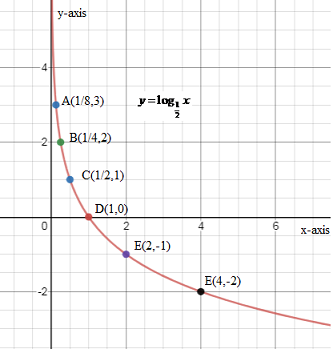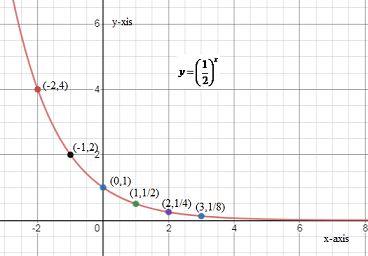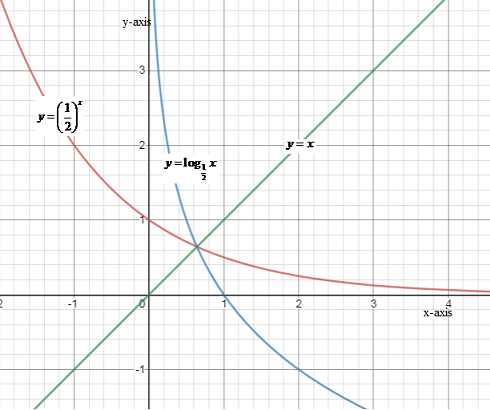
Sketch the graph of $y = {\log _{\dfrac{1}{2}}}x$ and $y = {\left( {\dfrac{1}{2}} \right)^x}$?
Answer
534k+ views
Hint: We have given two equations. The first equation is a logarithmic function and the second equation is an exponential function. To draw the graph of the logarithmic function, we substitute the positive values of $x$ as the domain of the logarithmic function is as the domain of the logarithmic function is ${R^ + }$ .
To draw the exponential function, we substitute all the real numbers as the domain of the exponential function is $R$ .
Complete step by step solution:
Step 1: We have given two functions: $y = {\log _{\dfrac{1}{2}}}x$ and $y = {\left( {\dfrac{1}{2}} \right)^x}$ . First, we draw the graph of $y = {\log _{\dfrac{1}{2}}}x$. For that, we substitute the different values of $x$ . The following table shows the values of $y$ for different values of $x$.
Step 2: Now we draw the graph of the logarithmic function $y = {\log _{\dfrac{1}{2}}}x$. Following is the graph of $y = {\log _{\dfrac{1}{2}}}x$

Step 3: Now, we draw the graph of $y = {\left( {\dfrac{1}{2}} \right)^x}$. For that, we substitute the different values of $x$ . The following table shows the values of $y$ for different values of $x$.
Step 4: Now we draw the graph of the logarithmic function $y = {\left( {\dfrac{1}{2}} \right)^x}$. Following is the graph of $y = {\left( {\dfrac{1}{2}} \right)^x}$.

Step 5: The plot of both the function on the same graph is as follows:

From the above curve, it is clear that both the curves are symmetric about the line $y = x$ .
Note: The logarithmic function is undefined for negative values of $x$ .
The value of the exponential function is always positive.
Graph of the logarithmic function and exponential function is symmetric about the line $y = x$. Choose the values of $x$ such that it is an integer power of the base, so we can determine the value of the logarithmic function.
To draw the exponential function, we substitute all the real numbers as the domain of the exponential function is $R$ .
Complete step by step solution:
Step 1: We have given two functions: $y = {\log _{\dfrac{1}{2}}}x$ and $y = {\left( {\dfrac{1}{2}} \right)^x}$ . First, we draw the graph of $y = {\log _{\dfrac{1}{2}}}x$. For that, we substitute the different values of $x$ . The following table shows the values of $y$ for different values of $x$.
| $x$ | $1$ | $\dfrac{1}{2}$ | $\dfrac{1}{4}$ | $\dfrac{1}{8}$ | $2$ | $4$ |
| $y = {\log _{\dfrac{1}{2}}}x$ | ${\log _{\dfrac{1}{2}}}1$$ \Rightarrow 0$ | ${\log _{\dfrac{1}{2}}}\dfrac{1}{2}$$ \Rightarrow 1$ | ${\log _{\dfrac{1}{2}}}\dfrac{1}{4}$$ \Rightarrow 2$ | ${\log _{\dfrac{1}{2}}}\dfrac{1}{8}$$ \Rightarrow 3$ | ${\log _{\dfrac{1}{2}}}2$$ \Rightarrow - 1$ | ${\log _{\dfrac{1}{2}}}4$$ \Rightarrow - 2$ |
Step 2: Now we draw the graph of the logarithmic function $y = {\log _{\dfrac{1}{2}}}x$. Following is the graph of $y = {\log _{\dfrac{1}{2}}}x$

Step 3: Now, we draw the graph of $y = {\left( {\dfrac{1}{2}} \right)^x}$. For that, we substitute the different values of $x$ . The following table shows the values of $y$ for different values of $x$.
| $x$ | $0$ | $1$ | $ - 1$ | $2$ | $ - 2$ | $3$ |
| $y = {\left( {\dfrac{1}{2}} \right)^x}$ | ${\left( {\dfrac{1}{2}} \right)^0}$$ \Rightarrow 1$ | ${\left( {\dfrac{1}{2}} \right)^1}$$ \Rightarrow \dfrac{1}{2}$ | ${\left( {\dfrac{1}{2}} \right)^{ - 1}}$$ \Rightarrow 2$ | ${\left( {\dfrac{1}{2}} \right)^2}$$ \Rightarrow \dfrac{1}{4}$ | ${\left( {\dfrac{1}{2}} \right)^{ - 2}}$$ \Rightarrow 4$ | ${\left( {\dfrac{1}{2}} \right)^3}$$ \Rightarrow \dfrac{1}{8}$ |
Step 4: Now we draw the graph of the logarithmic function $y = {\left( {\dfrac{1}{2}} \right)^x}$. Following is the graph of $y = {\left( {\dfrac{1}{2}} \right)^x}$.

Step 5: The plot of both the function on the same graph is as follows:

From the above curve, it is clear that both the curves are symmetric about the line $y = x$ .
Note: The logarithmic function is undefined for negative values of $x$ .
The value of the exponential function is always positive.
Graph of the logarithmic function and exponential function is symmetric about the line $y = x$. Choose the values of $x$ such that it is an integer power of the base, so we can determine the value of the logarithmic function.
Recently Updated Pages
Master Class 12 Economics: Engaging Questions & Answers for Success

Master Class 12 Maths: Engaging Questions & Answers for Success

Master Class 12 Biology: Engaging Questions & Answers for Success

Master Class 12 Physics: Engaging Questions & Answers for Success

Master Class 8 Maths: Engaging Questions & Answers for Success

Class 8 Question and Answer - Your Ultimate Solutions Guide

Trending doubts
What is meant by exothermic and endothermic reactions class 11 chemistry CBSE

10 examples of friction in our daily life

One Metric ton is equal to kg A 10000 B 1000 C 100 class 11 physics CBSE

1 Quintal is equal to a 110 kg b 10 kg c 100kg d 1000 class 11 physics CBSE

Difference Between Prokaryotic Cells and Eukaryotic Cells

What are Quantum numbers Explain the quantum number class 11 chemistry CBSE




